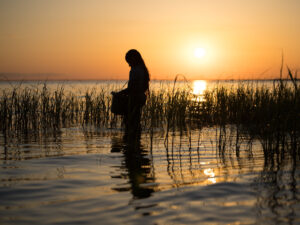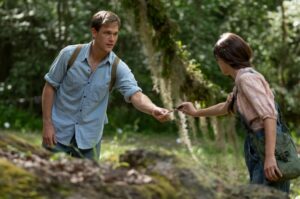“Where the Crawdads Sing” – There Nature’s Story is Born [Review]

Title: “Where tthe Crawdads Sing”
Release Date: 2022
Director: Olivia Newman
Cast: Daisy Edgar-Jones, Taylor John-Smith, Harris Dickinson, David Strathairn, Michael Hyatt, Logan Macrae, Bill Kelly
Delighted by Delia Owens’ debut novel “Where the Crawdads Sing,” I eagerly awaited its film adaptation. And here it is – a picture by Olivia Newman – faithful to the book story and patiently following the voice of the American writer. Perhaps too patiently… because plot correctness has drained some of the magic from the story of the mysterious Swamp Girl, who, abandoned by her own family, tries to survive in the wild wetlands of North Carolina. Nevertheless, the film is certainly worth seeing, if only because it manages to convey the main idea of Owens’ novel: that the best teacher of life is nature, which resists moral judgment. But her voice can only be heard “where the crawdads sing”.
“Where crawdads sing” – a fascinating marriage of science and literature
“50 weeks on the New York Times bestseller list” for some sounds like a tempting incentive to read, for others not necessarily – an advertisement that is not always matched by good literature. I belong to the latter group of readers, so the similar label on the cover of Delia Owens’ debut novel didn’t bring me to my knees. Instead, it succeeded with a book written with tenderness, brilliance and charm by an American writer who has spent her entire life so far engaged not in literature but in science! “Where the Crawdads Sing” is a real surprise for me, as the author revives well-known plot patterns with the help of what many readers of novels bypass with a wide bow: descriptions of nature!
The point is that in Owens’ case these are not so much mere literary embellishments, but observations backed by extensive knowledge and erudition, from which the fascinating spirit of this prose is born: the conviction of man’s spiritual and physical connection with the eternal order of nature. What’s more, sincerely in love with the North Carolina wetlands, the author does not bore the reader with scientific jargon, but her language exudes poetic lightness, building before the reader’s eyes a picture of a land that is half-magical and fully unknowable.

Who could write a similar book better than Delia Owens, a wildlife researcher with an extremely interesting biography. In 1974, the zoologist and her husband traveled to Africa, where she spent more than twenty years studying the ecosystems there. She lived in Botswana and Zambia. She published her work in the most prestigious scientific periodicals, such as Nature, Natural History and International Wildlife. In 2019, she settled near Asheville, North Carolina. She has chronicled her biography in three best-selling books, including the publication “Cry of the Kalahari”. The novel “Where the Crawdads Sing,” published in 2018, is her first fiction item, which has received huge publicity thanks to the interest of famous actress and film producer Reese Witherspoon.
“Where the Crawdads Sing” – the story of the Swamp Girl
“Where the Crawdads Sing” – both the film and the book – is a combination of several genre conventions. For here we have a coming-of-age story, a love melodrama and a detective story in one. The main character of the film is Kya (played by Daisy Edgar-Jones), who from an early age struggles with the hardships of existence in a wetland far from civilization. At just six years old, abandoned by her mother, then by her siblings and finally by her abusive father, she has to face on her own the problems that would overwhelm many adults. The situation is not made any easier by the overt dislike shown to the growing girl for several years by the residents of a neighboring wetland town.
The prejudice held against her by the local community reaches a crescendo when one day the body of a dead Chase Andrews (Harris Dickinson) is found under the lookout tower. When it comes to light that in the past Kya dated local Don Juan and was subsequently abandoned by him, the heroine becomes the prime suspect in the murder case. The swamp girl, with the knowledge of her impending death sentence, will have to stand eye to eye with the Barkley Cove jury, who will decide her life or death.

The film “Where the Crawdads Sing” – correctness at the expense of magic
The film “Where Crawdads Sing,” directed by Olivia Newman, is a correct adaptation with undoubted strengths. The director managed to coherently tell Kya’s story and at the same time emphasize her sensual connection with nature, the natural environment in which she grew up. The latter manifests itself in the film on a visual level (Polly Morgan’s stunning cinematography), but also in the character’s personal comments. Of particular importance for the plot are the girl’s words repeated in the opening and in the finale of the production: “A swamp knows all about death, and doesn’t necessarily define it as tragedy, certainly not a sin”. “Tragedy” and “sin” are two key formulas describing and explaining the film’s criminal plot, which the filmmakers skillfully used in building the plot sequence of events.
The lyrical note of the film adaptation is not only the wonderful shots of the coastal landscape, animal behavior and the extremely touching ending, but also the beautiful song “Carolina” by Taylor Swift. In the film’s favor is undoubtedly the involvement in the main role of a young (already, I think) star – Daisy Edgar Jones. The British actress became famous for her ethereal performance in the serial adaptation of another famous novel – “Normal People” by Sally Rooney. Kya from “Where the Crawdads Sing” is, in her interpretation, an extremely sensitive, gentle and intelligent girl. The only thing I personally missed in the portrayal of the heroine was a note of exoticism and a kind of magic. After all, Kya from Owens’ novel is an ambivalent character: on the one hand rational, on the other, somehow drawn from the myth of the exotic woman. She has something of the beautiful siren luring men into temptation.
It is her otherworldliness that most intrigues the male part of the local community. The appearance of the novel’s Kyi is different from the fashionable girls of the town. Her outfits are a bizarre juxtaposition of second-hand items given to the girl by Jumper’s wife. Meanwhile, the film’s Kya is a typical teenage girl with clothes that lie on her as perfectly as if they were tailor-made. The filmmakers may have tried too hard to emphasize the contrast between the prejudices of the townspeople and reality. However, there is no denying that Owens constantly marks the dissimilarity of her character, while here her character is overly normalized. And this is a pity, because it comes at the expense of the somewhat fairy-tale atmosphere of the book and takes away the poetry of the girl’s unusual and unique relationship with nature.

“Where the Crawdads Sing” – the truth of the body and the truth of reason
The director of “Where Crawdads Sing” with varying degrees of luck tries to outline the dissimilarity of Kyi’s love relationships with two men. I get the impression that the relationship with Tat (Taylor John Smith) and with Chas merge into a very similar melodramatic narrative, only that with two different finales. Meanwhile, in the novel, these two relationships differ like the proverbial fire and water, and what’s more, it’s the two that highlight the ambivalent nature of the heroine. Tate, with whom Kya forms a romantic bond, is part of her more rational side: he teaches the girl to read, provides her with readings, and gives her the basis of an extensive natural science education.
The relationship with Chas, on the other hand, is eminently erotic in nature. It is full of passion, desire and mutual carnal attraction. In one notable scene in “Where Crawdads Sing” – when Chase takes Kya to a lookout tower, the heroine says that the man “showed her a whole new perspective.” It’s a perspective of flesh and sensuality, but also of predation and dark instincts.
“Where the Crawdads Sing” – nature a teacher of life
Most important to me, however, is that the film “Where the Crawdads Sing” does not negate the most important message of Delia Owens’ novel. Kya, thanks to her unique story, is an integral part of the wetlands, feeling their mysterious rhythm like no one else, and at the same time she is an observer with the scientific skills to describe and understand the world she lives in. Deprived of a normal home, family, school and social relations, she learns everything from the nature around her. The mating rituals of animals, their behavior in the herd, and the acquisition of food provide her with extensive knowledge of love, loneliness and rejection by the group.
Moreover, the order of nature also shapes the Swamp Girl’s moral values and attitude to life and death. This makes Kya confident that her own person in the ongoing murder trial does not play a leading role. For it is not her that the Barkley Cove jury will judge, they will judge themselves as a community. In turn, the truth will perhaps remain hidden deep in the wetlands, accessible only to someone with the courage to reach “where the crawdads sing.”
